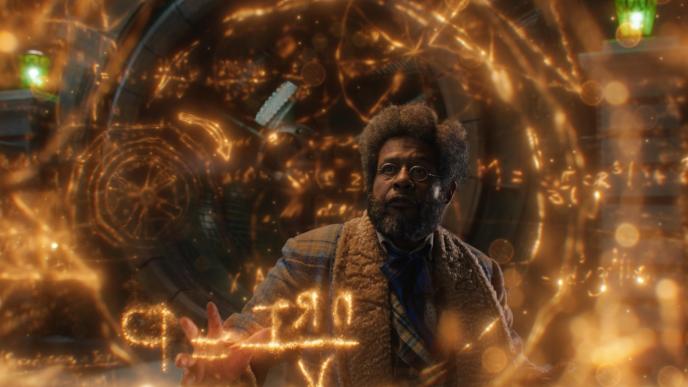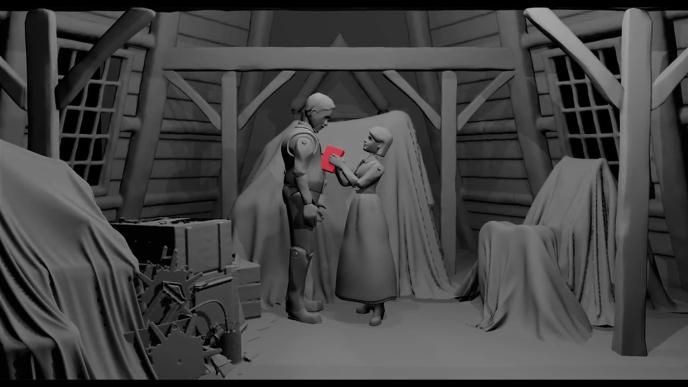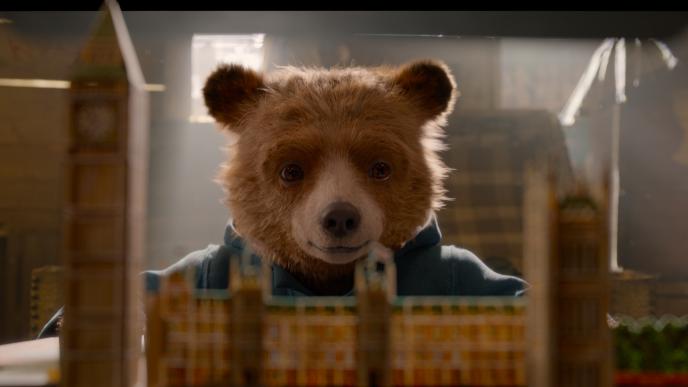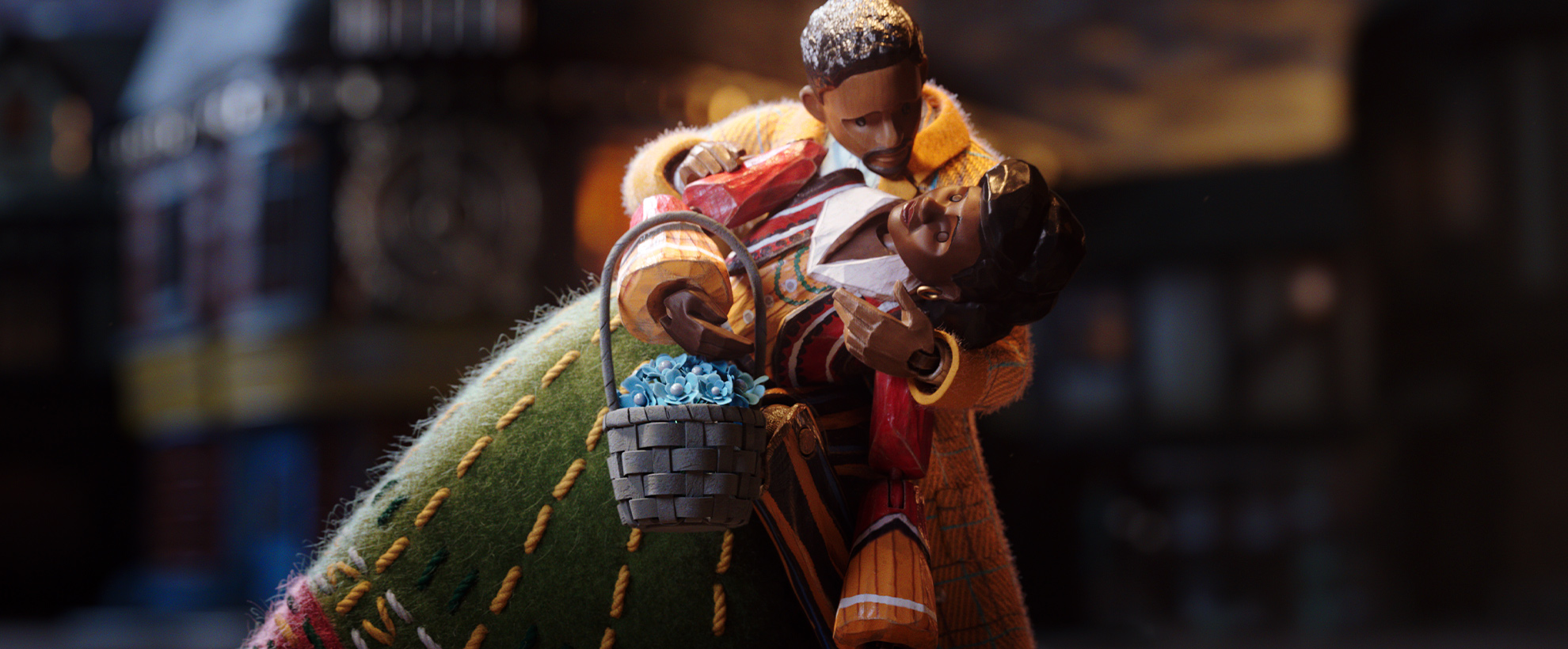
Jingle Jangle: A Christmas Journey - Storybook Sequences
Framestore has created a number of stunning animated sequences for Netflix's flagship holiday movie Jingle Jangle: A Christmas Journey. The Framestore team behind the sequences, under the guidance of overall VFX Supervisor Brad Parker and led by Animation director Ian Spendloff and VFX supervisors Tim Jenkinson and Johannes Sambs, created nearly eight minutes of full CG animation, designed to reflect the magically-inventive aesthetic of David E. Talbert’s film and establishes a world within a world which is loaded with emotional resonance.
I wanted something innovative that no one had seen before. What Ian and Framestore came up with blew me away — full CG characters that look like the wooden toys that Jeronicus would have carved himself. Big win for Framestore, bigger win for my film!

Concept
A storybook structure was used in the CG sequences which top and tail the film as well as serve as narrative bridges for important parts of its story which revolves around the family of eccentric toy-maker extraordinaire Jeronicus Jangle. ‘We wanted these storybook sequences to be told in a way that Jeronicus the toy maker would tell them, something that would reflect his character; playful, inventive, different,’ says Ian. ‘So I came up with the idea of a miniature mechanical, clockwork world all contained within the actual book itself. Tiny hand crafted wooden versions of the film's characters, playing out scenes in tiny little mechanised sets that self-assembled.’
As a proof of concept, Tim Jenkinson created some animated render tests to showcase these ideas, visualising how the team would ‘shoot’ the miniatures that would ultimately be built in CG. He said; ‘it was important to work out how the sequences would look but also how we could use an ever-changing mechanical environment to help drive the story.’


Design & Development
The idea that Jeronicus, the film’s central character created this book served as the definition of how everything would be designed and executed by the team. It was agreed at the start that the world the team were creating had to feel like it was actually built into the book. ‘We wanted to sell the idea he’d actually carved, painted, and rigged up these automated figures and sets,’ commented Spendloff.
Explains Jenkinson; ‘We spent a lot of time defining the laws and restrictions in which the world would be built. This had to look real and hand made; we had to bear in mind endless considerations around how Jeronicus would have built these models. Everything from what materials and tools he’d have used, to how he’d construct miniature pieces of furniture and the environments. In doing this, tangibility and imperfection were absolutely key. And we had to answer all those questions within a 3D workflow.’
Everything from the lighting and the costumes to the rain effects seen in the sequences had to be approached in this way. The questions about how went right the way through the project, all the way to comp. Tim Jenkinson felt these limitations and demonstrating restraint were integral to the project because it’s possible to effectively do anything when working in full CG. The team however didn’t want to turn the VFX up to eleven but instead make something that looked and felt real.


A lot of effort went into making sure the materials used were the right type, the textures the right scale and elements moved in the appropriate way. ‘We were always looking at real world ways of bringing these sequences to life,’ says Lucy Hare. ‘During lock down my Mum even kindly stitched us up some teeny felt skirts so we could see how the fabric folds and reacts at that size.’
All the sequences’ buildings were designed to fold up and self-assemble with visible hinges and joins, designed as a cross between theatrical flats and tiny mechanised dollhouses. The team developed a system to make each house build up each in a unique way. Even if you don’t see a structure being assembled, it had to look like it could.
The background characters that fill these environments were flat hand drawn illustrations fed through a custom-built procedural tool that turned them into 3D assets, adding texture and basic appendage joints - even some wear and tear to make the models look aged.
‘Everything we did was a balance between what could be done technically and creatively and how those two things would have a narrative impact,’ says Johannes. ‘This was a project that presented us with constant challenges. Mostly because of the creative constraints set by us. But it meant we had a really inspiring culture of problem-solving right the way throughout.’
Camera & Transitions
The plan right from the start was for the sequences to have a continuous flow, as if they were shot in one take. This was worked out early on with Framestore Pre-Production Services (FPS), planning carefully how the camera would gracefully move from one scene to the next and accelerate timeframes in order to move the narrative forward. ‘I had storyboarded and edited all the sequences, but things really opened up when FPS came on board,’ comments Spendloff. ‘It was great figuring out with them how to get from one set up to another in interesting and fluid ways.’

Multiple scenes were seamlessly blended to create the illusion of one long take, and with lighting and depth of field being just as important as the camera and character performances, effects were added even at this early stage.
Getting in and out of the sequences from live action was also a key consideration, and David E. Talbert was keen for the team to come up with interesting ways to achieve this. A fun but tricky challenge, the team wanted the audience to be drawn in by the magic of the sequences. So while multiple transitions are present in the sequences, each was unique with cuts hidden as the camera moved through scenes in a way that created a seamless and continuous flow of action.
Character Performance
The sequences had to do some heavy lifting narratively, one in particular being a mini movie in itself; covering a 20 year span and featuring some major moments in the lives of the Jangles family. When discussing this sequence with David, it was clear to Ian that it needed a big emotional response from the audience because it contained huge character motivations seen throughout the rest of the film. ‘We needed to make sure we got the right performance out of our wooden cast so we had to find the right balance between the mechanical nature of our world, and the need to empathise and feel for the characters,’ he commented.
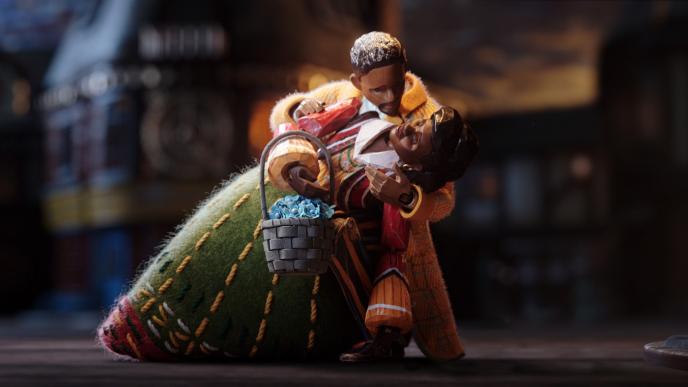

The rules and narratively-driven discussions resulted in an automation style of animation that Ross Burgess, Framestore’s Animation Supervisor on the project hasn’t seen done in CG before. The team had to make sure that every movement was considered and justified by the mechanics of the tiny world. Commented Burgess;, ‘The reason this style worked was it gave the impression that the characters were wooden objects moving as a result of mechanisms like tiny cogs or wire as opposed to being living characters with motivations and brains.’
As well as their movements, the team also had to work out the best way for the characters to emote because the established rules for the world meant that they couldn’t simply animate faces to express an emotion.‘There were some strong and nuanced emotions to represent in these sequences. It was a challenge to effectively communicate that with wooden figures. Instead we found creative ways to cut between digital models with different facial expressions in order to play out the emotional scenes,’ explains Johannes Sambs.
Titles & Closing Credits
Alongside the storybook sequences, the team also designed and animated the films opening logo intro, and created two and a half more minutes of 4K, full CG closing credits, a part of the project they were really passionate about. Ian Spendloff came up with an epilogue which shows what happens to the family after the events of the film, using the little wooden cast. ‘It’s another short film itself, and a fun way to wrap up the film,’ added Ian.
Again, FPS handled the previs for this sequence and Tim Jenkinson led the incredibly fast turnaround for both title sequences, all of which was lit, rendered and comped in just three weeks.
‘It was a really nice way to both showcase the characters, props and the world we had lovingly created and even do more with them,’ recalls Tim. ‘The film’s main character Journey for example, only has a tiny part in the storybook sequences. But here she gets to have her moment and interact with the rest of the characters. It was a great way to end both the film and the project.’

Over 18-months the team created nearly eight minutes of full CG in 4K which features 250 CG assets; 21 3D characters, 59 2D characters and 170 different props and environments.
‘David’s vision for this film is unique and we loved getting into the mindset of that and helping to bring it to life. We had a great relationship with David and his whole production team, and greatly appreciated their trust and confidence in us’ concluded Johannes Sambs. ‘What we’ve created is something that’s as technically-impressive as it is visually captivating.’
A huge thank you to all the team at Framestore that brought these sequences to life.
Press
Inside the VFX behind Netflix’s ‘Jingle Jangle: A Christmas Journey’ - What's On Netflix?
Multi-angle on 'Jingle Jangle': Part 1 - The Storybook Sequences - Befores and Afters



